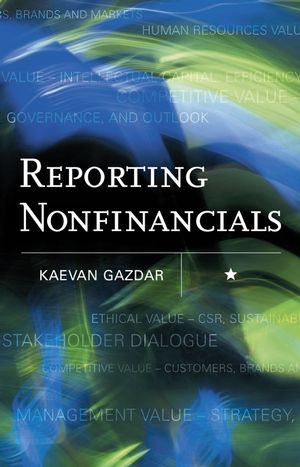Reporting NonfinancialsISBN: 978-0-470-01197-3
Hardcover
346 pages
March 2007
 |
||||||
Acknowledgments.
Introduction: Goodwill and Blue Skies?
Getting a Grip on Nonfinancials.
Closing the gap between book value and market cap.
Step 1: Classifying nonfinancials.
Step 2: Adjusting to regional priorities.
Step 3: From consciousness to action.
PART I: THE WHY.
1 True and Fair View?
The Glaring Deficiencies of Financial Reporting.
The old economy’s reporting paradigm.
Change reporting, not accounting.
Getting form to follow function.
Nonfinancials: The overheads of the 21st century.
2 Open Sesame?
Nonfinancial Reporting between Pressures, Paradoxes and Potentials.
Pressures: Regulators, investors and public opinion.
Paradoxes: A singular lack of clarity and concreteness.
Potentials: Professionalisation on the march.
PART II: THE WHAT.
3 Competitive Value.
Brands, Customers and Markets.
A. BRANDS: ENGINES OF GROWTH AND REPUTATION.
Calculating brand value....
...and reporting on brand equity.
Rescuing the brand: Reporting as a part of crisis management.
Strategies for product....
...and corporate brands.
B. CUSTOMERS: THE KEY ENTREPRENEURIAL ASSET.
Customer orientation: Beyond lip worship.
Customer loyalty: Beyond retention.
Customer satisfaction: Early warning system or success barometer?
Customer commitment: Showing true grit.
C. MARKETS: TARGETING NICHES, SEGMENTS AND SECTORS.
Marketing metrics: From market share....
...to sectorial insights.
Marketing strategy: Between brand positioning....
...and financial results.
SUMMARY OF COMPETITIVE VALUE.
4 Management Value.
Strategy, Governance and Outlook.
A. STRATEGY: AN AMALGAM OF PROCESSES AND VISIONS.
Systematising strategy: Concentrating on targets....
...and on market trends.
Strategy as a structured process....
...and as an exercise in restructuring.
Strategy derived from the vision of a leader....
...and his insights on markets – or hers.
B. GOVERNANCE: SHADES OF TRANSPARENCY.
Regional pressures and structural differences.
Are governance premiums sufficient incentives for coherent reporting?
Reporting approaches: Between formalism....
...and hardcore information.
C. OUTLOOK: FORECASTING AS THE ULTIMATE CHALLENGE.
Between expectations and regulations.
Inputs and outputs: Systematising forecasting.
Uncorking the champagne – or biting the bullet.
Paths to growth and glory: Unorthodox approaches.
SUMMARY OF MANAGEMENT VALUE.
5 Human Resources Value.
Productivity, Motivation and Potential.
Can people be capitalised? Ambitious concepts, modest results.
Leveraging human resources: Pinpointing indicators....
...and reporting coherently.
A. PRODUCTIVITY: PROMOTING EFFECTIVITY AND EFFICIENCY.
Ways to productivity: The cultural factor.
Factual approaches: From basic documentation....
...to a strategic overview.
Focusing on the essentials.
B. MOTIVATION: WILD CARD FOR EXCELLENCE?
Corporate culture: The backbone of motivation.
Mobilising employees: Between satisfaction....
...and engagement.
C. POTENTIAL: PROTECTING PROPERTY AND HARNESSING TALENTS.
Exploiting intellectual property: Defensive and offensive approaches.
Managing diversity: Qualitative solutions....
...and quantitative evidence.
Training: An investment in superior performance.
SUMMARY OF HR VALUE.
6 Ethical Value.
CSR, Sustainability and Stakeholder Dialogue.
Good ethics=superior financial performance?
Evolution of reporting: From accounting to assurance.
A. CORPORATE SOCIAL RESPONSIBILITY: CHARITY OR POLICY?
Reporting trends: Quantity and quality on the rise?
Concretising commitment....
...and concentrating on core business.
An emphasis on issues....
...and on mission.
B. SUSTAINABILITY: BETWEEN TRIPLE BOTTOM LINE AND REALISTIC TARGETS.
Reporting between minimalist requirements and maximalist demands.
From triple bottom line....
...to challenges and dilemmas.
Setting targets and executing strategies.
C. STAKEHOLDER DIALOGUE: CONFLICT-SHOOTING OR WIN–WIN STRATEGY?
Curing corporate myopia.
Systematising processes, developing indicators.
Addressing specific issues....
...and systematising consultation.
Ethical value: A must or a sham?
SUMMARY OF ETHICAL VALUE.
PART III: THE HOW.
7 Says Who?
Addressing Stakeholders and Facing Issues.
Low standards of accountability....
...and cultural proclivities.
Focusing on audiences: Communities, employees....
...the financial community.
...and NGOs.
Focusing on specific issues....
...and tackling general concerns.
Dialogue as an ongoing process.
Dialogue perspectives: From evasiveness to civic sense.
8 New Wine in New Bottles?
Strategy, Structure and Style.
Strategy: From fundamental questions to an integrated approach.
Structure: The road to clarity and materiality.
Style: From story-telling to substance.
Coherence, brevity, accountability.
Bibliography.
Index.



